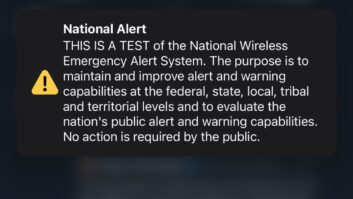Text has been updated to correct the affiliation of Scott Solko.
Today’s alerting test went off at 2:20 pm Eastern but hit a more than a few potholes along the way.
The Federal Emergency Management Agency conducted an IPAWS/EAS test that was to cover a sizable part of the nation: 22 states, two territories and the District of Columbia.
But there were hiccups in the process, and six states were dropped from the test with little to no warning to participants due to concerns about real weather activity.
In Florida, authorities cancelled the participation in the test due to severe weather. A cancellation notification was apparently sent via email to Florida Association of Broadcasters members, said Scott Solko, a consultant for Magic Broadcasting, “but non-members got no notice,” he said. “It is not posted on the FAB website, and I called, and was told that the FAB has nothing to do with the test. Very scary stuff.”
There was also miscommunication in Alabama, where the anticipated test was not delivered, much to the chagrin of the state association president and several stations.
“Alabama did not get the test,” said Larry Wilkins, contract engineer for the Alabama Broadcasters Association. “We found out that someone with the state asked to have Alabama removed from the list because of weather. The sad thing is nobody let the state EAS committee know. As a result we had stations sitting by their EAS units waiting for it. I can’t seem to find out where the order came from.”
Al Kenyon, the technical lead for IPAWS, confirmed that Florida, North Carolina and Virginia were dropped from the test at the request of the respective state emergency management agencies; and that Alabama, Louisiana and Mississippi were dropped upon the recommendation of the National Weather Service due to on-going recovery activities in those states following overnight severe weather.
But apparent miscommunication has led to frustration for more than a few broadcasters.
“As president of the Alabama Broadcasters Association, I would like to have known that our state was going to be dropped from the test when that decision was made today,” posted Sharon Tinsley on an EAS exchange listserv managed by the Society of Broadcast Engineers after the test was completed. “Our state [emergency management] office was not informed in advance either,” she said. “We’ve been working diligently with our stations for weeks to make sure they had the NPT code set.”
As a result, stations expecting to receive the test — who were not informed that the test was not forthcoming — were left waiting. That was the case for station WQMR(LP) in Rocky Mount, Va., who confirmed that the station did not receive the test, said Don Mattingly, engineer with WQMR(LP).
For stations in a number of states, the test went off without a hitch, including at station WAMU in Washington, D.C.
“We received messages and forwarded them all,” said Chris Whitfield, technical operations manager for the station. “[We] got a little worried when they didn’t hit at exactly 2:20:00 p.m., but they started to come in about 2:20:50 p.m. A network delay I suppose.”
Radio World had posted a request for station comments. A number reported smooth sailing, such as WCMY(AM) and WRKX(FM) in Ottawa, Ill.; WBEB(FM) in Philadelphia; WICB in Ithaca, N.Y.; and WRBS(FM) and WRBS(AM) in Baltimore. “All went well with today’s NPT on our two stations in Baltimore,” said Peter J. Allen, chief engineer for the Baltimore stations.
“We received the test on all four of our stations and forwarded it out,” said William Stachowiak, chief engineer for WMSX(FM), WYRK(FM), WBLK(FM) and WBUF(FM) in Buffalo, N.Y.“The audio quality was good.”
Others said the test worked just as planned. That was the case for station KFKX in Hastings, Neb. “The sound quality was very good,” said Barton A. Jones, chief engineer for KFKX. “The voice quality was slightly clipped, but totally understandable. I do not know if it was transmitted by FEMA this way, or if I have an internal setting up too loud.”
Others were more mixed in their sentiments about the audio.
“Our test went off fine, but the voice announcement was running extremely slow, about a tenth of normal,” said Tommy Gray, senior director of broadcast engineering and technology for KSBJ in Humble, Texas. “[But the] recorded audio [was] seriously bad.”
Audio was also an issue for Nebraska station KJSK(AM) in Columbus. “The test went off and aired without a hitch here in Nebraska at our stations,” said James Nickel, program director for the station. “[The] audio sounded a little noisy,” which Nickel attributed to over modulation of the announcer audio. “Just a little too loud. But it was completely understandable.”
Others said the audio quality was stellar.
“Wow. If only the audio from the LP1 would sound like this,” said Marty Wind, general manager with KLUX in Corpus Christi, Texas. ”[It was] clean, clear, and with a single two-tone alert in front of the message. [It was a] great test for us. Could not have gone better.”
Share your own experiences. Email [email protected].










